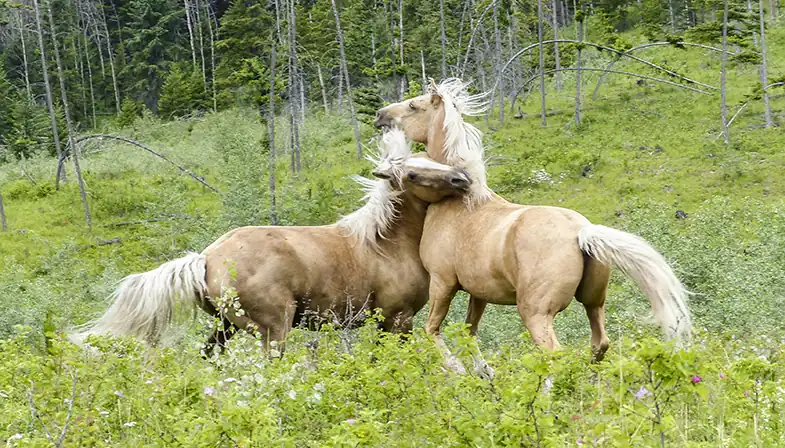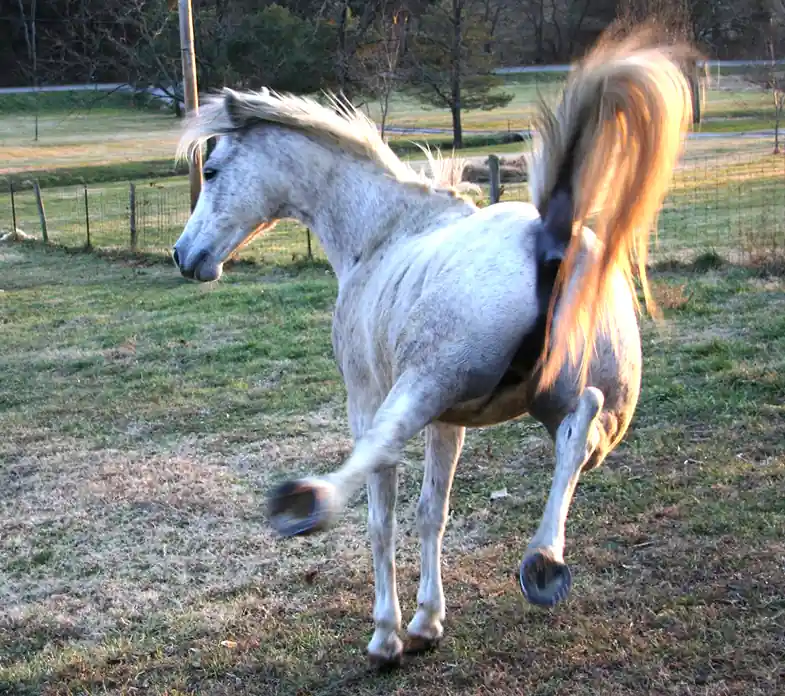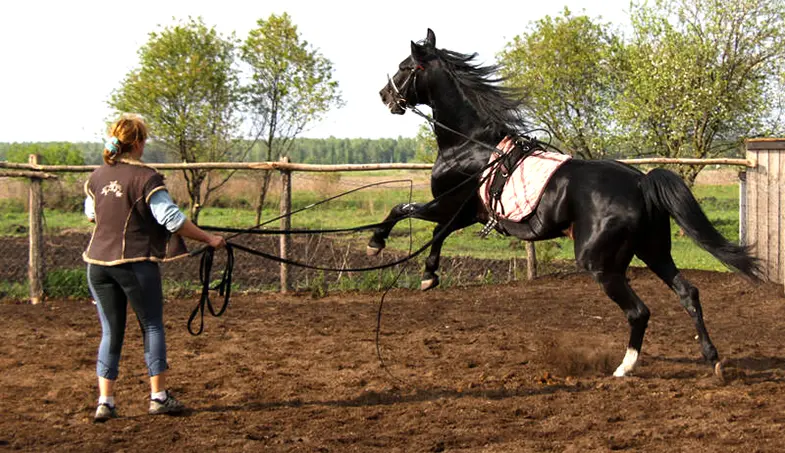As a rule, horses are gentle, mild-mannered creatures that, despite their size, are generally friendly and affectionate towards humans but sadly this isn’t always the case. The good news though is that there is no such thing as a bad horse and no horse will display aggression purely for fun. Once you’ve identified what is causing the aggression you can begin to address the issue and correct the behavior.
How do you deal with an aggressive horse? Horses can display aggression for a number of reasons which is why you should first speak to your vet. If they rule out a medical condition then you need to reassert your role as leader and teach your horse to respect you which can easily be done with groundwork.
Why is my horse being aggressive all of a sudden?
If your horse has suddenly become aggressive and without any obvious indication as to why then you should speak to your vet. They’ll be able to check your horse and run tests to make sure there’s nothing physically or hormonally wrong with them.
If your vet has given your horse a clean bill of health, albeit in the physical sense, then it’s time to look for another reason for this sudden change of behavior. Has there been a recent change at the yard, have you changed your routine or your horse’s diet? If you answer no to all of these then it’s possible that this change in behavior isn’t so sudden and that you might have missed signs that something is wrong.
Why is my horse being aggressive towards me?
You might be surprised to know that aggression is part of the normal behavioral pattern of horses, they often use it to assert their dominance within a herd. That said though if they’re being overly aggressive towards other horses or turn that aggression towards us then this natural behavior can be a problem and the first thing you need to do is establish the cause.
Chronic pain
Horses that have been suffering from some sort of pain for a long period of time can become aggressive out of sheer frustration. At first, the pain may manifest itself in a slight change in personality or eating habits but if you ignore these signs, for whatever reason, your horse will slowly resort to a more drastic method in an attempt to draw your attention to his pain.
Fear
Much the same as is with horses suffering pain, horses that feel trapped and unable to escape a situation can become aggressive as they start to panic. This is particularly common in horses that haven’t been properly trained to load a trailer but can also be seen anytime a horse doesn’t feel he has an escape route.
Association
Horses can sometimes react aggressively to a situation if they associate it with something negative, frightening, or even painful, even if the circumstances are completely different this time. For example, if your horse has a painful injury on his upper leg that you need to dress he may react aggressively every time you try to touch that area. Not because it hurts anymore but because he associates you touching his upper leg with the previous pain.
Dominance
As I say horses can use aggression as a way of asserting their position within the herd but, while this is normal it should never be used against people. Horses that don’t respect their owners or handlers will often try and dominate them and will enforce their ‘boss’ role aggressively.
Testosterone
I know you’re probably thinking that this cause is reserved solely for stallions competing for the attention of a mare but this isn’t always the case. Yes, of course, it’s far more common in stallions but both geldings and mares can become aggressive due to high levels of testosterone, although it does tend to only happen when they’re suffering from certain medical conditions. In geldings, this can be ailments such as pituitary tumors or undescended testicles, while ovarian or adrenal-gland tumors in cause it in mares. In these cases, your vet should be able to advise you of the best course of action.
How do horses show aggression?
Every horse is different and they all display different levels of aggression and show it in varying ways but typically aggressive horses will show that trait in one or more of the following ways.
- Biting – Not all horses will actually bite you, some will threaten to do so instead.
- Kicking – Along with biting, kicking is probably the most common sign of aggression.
- Pushing – While horses can get overly excited sometimes (especially when theirs food around), some horses will try and push you out of the way or against a wall as a sign of aggression.
- Charging – This is more common when horses are turned out but they can charge at people as a way of intimidating them.
- Bucking – More common with ‘riding’ aggression, horses that are in pain when being ridden or are getting bored or frustrated may start bucking.
- Rearing – Like bucking, this is more common in horses that are being ridden.
How do I handle an aggressive horse?
The first, and most important, thing to do when handling an aggressive horse is to make sure you (and other people) are safe.
If the horse is known to kick then don’t approach him from behind and try to avoid being within kicking distance. Likewise, if a horse tries to bite people then approach from the side so he can see you but make sure you can easily jump back if he does try to bite you.
After this, the way you handle the horse will largely be dependent on why he’s being aggressive. After all, if the horse is frightened of being touched around his head or neck then throwing a lead line around him won’t help. Whereas if a horse simply doesn’t want to do what you’re asking of him then you need to be confident and firm with him.
You should be confident when handling an aggressive horse but always be respectful of why they’re being aggressive in the first place. Don’t presume they’re just being nasty, they may be trying to tell you something is wrong.
The one thing you should never do with an aggressive horse though is punish them by hitting, kicking, or punching them in any way. It might make you feel better in the short term but your horse won’t forget it and in the long run, it’ll only make the problem worse.
How do I correct my horse’s aggressive behavior?
Aggressive horses can be unpredictable, especially if the behavior is caused by pain or fear, so the first thing to do is to make sure you have an escape plan if you feel that you’re in immediate danger. You can always come back to correcting the behavior later.
There are four main types of aggression in horses (pain, fear or association, dominance, and feeding) and how you deal with this is dependent on the reason for their behavior.
Pain
If your horse’s aggression is due to pain then the first thing to do is find out what’s causing the pain. Your horse’s reaction to certain situations will help you to understand exactly what the cause is, for example, if he’s only aggressive when you groom his back then it’s a sure sign that he has some sort of back pain or weakness in his back. Likewise, if he only becomes aggressive when you ride then he could be suffering from back or dental pain.
Once you’ve established the cause of your horse’s aggression you can then start to address the problem, which will often be to simply remove the source of the pain. If your horse is suffering from chronic pain (ie pain that has lasted for six months or more) then he may still be acting aggressively because the aggression has become part of his behavior. Don’t worry though, this can still be resolved in the same way as mentioned with association pain below.
Fear or association
You might think that it’s difficult to stop a horse’s aggression if it’s borne out of fear but to some extent, it’s actually a lot easier, although it can often be slower. You need to be calm, patient and always make sure your horse feels safe and comfortable around you, you can easily do this by bonding with your horse.
Horses rarely act without telling you beforehand what they’re going to do or how they feel, paying attention to your horse and his body language can help you to quickly identify (and sometimes resolve) the trigger. For example, if your horse is aggressive when he’s in his stall turning him out or making the stall more horse-friendly (with lavender oil, horse toys, and horse safe mirrors) can often stop the behavior immediately.
If your horse is scared of being touched in a particular place then you can help him to overcome this by slowly exposing him to being touched on the problem area. You can do this by using lavender oil to relax your horse then, slowly stroke the area that’s causing the problem. Do this slowly to start with and, when your horse accepts what you’re doing, stop straight away and praise him. In time you’ll remember you praising him and will forget about the fear.
If your horse is fearful of being clipped, for example, then show them that there’s nothing to be fearful of. You can do this by slowly exposing him to the clippers, start by letting him see the clippers then when he’s relaxed put them away and praise your horse. Next time allow him to sniff them before putting them away again and praising him once more, next time start by turning them on and allowing him to look at them at arm’s length. Each time you do this your horse will become more and more relaxed and comfortable around them until you’re able to switch them on and clip him.
Association aggression can be dealt with in the same way, slowly and calmly allowing him to get used to whatever it is that’s troubling him. It might take a while but it’s crucial that you do this at your horse’s pace and that you don’t force him to do anything he’s not comfortable with.
Dominance
When a horse uses aggression to assert its dominance it’s crucial that this sort of behavior isn’t allowed to continue but it can take time and needs a confident handler. The aim of this is to train your horse to respect you, understand what’s acceptable as well as what isn’t, and also to establish your role as the leader.
The best way of doing this is to lunge your horse, this will get them to focus on you and, in time, work with you. Regardless of whether you’re using a round pen or free lunging your horse, you should keep him moving in circles until you’re ready to stop him. If he stops before you ask him to, get him to move again as quickly as possible, either by using your voice or by snapping the whip or rope behind him (don’t hit him with it though). As soon as he does what you’re asking him to do, and starts to relax, get him to stop then walk up to him and praise him.
If, at any point, your horse responds to this by turning his hindquarters towards you or tries to kick you should counter this by making him move forward in the circle again. This will take the impetus out of his aggression and force him to think about his feet.
You might think that this is too simple to work, but if you do it regularly, every few days, your horse will, in time, learn that you’re the boss and will respect you too, this will also stop his aggression.
If you’ve never lunged a horse before or aren’t sure you’re confident enough to do this then there’s no shame in asking a professional to help. Working with an aggressive horse takes courage and experience so if you’re not sure it’s safer for you and your horse to ask somebody to help.
Feeding
Horses can often get very excited and impatient when it comes to mealtimes which can sometimes lead to aggressive behavior. While this is rarely directed at anyone and is more of a ‘hurry up and feed me’ statement it should still be discouraged, even if only to stop your horse from hurting himself or damaging the stall door.
You might think that giving your horse his food stops the behavior but this is only a temporary thing and he’ll start again when it’s time for his next feed. Rather than stopping the behavior, in your horse’s mind, you’re actually rewarding it, making him think he’s doing the right thing. I’m not saying that you should withhold food, but instead either feed him after you’ve fed the other horses or as soon as he stops kicking, whichever happens first.
Further reading
- Why punishing horses doesn’t work
- How do I stop my horse kicking?
- Why’s my horse pawing the ground?
- How to reduce your horse’s anxiety
- Understanding horse body language
- Do horses suffer from depression?
- How hard can a horse kick?
- Learn to successfully load your hrose
- How to catch difficult horses, every time
- 10 common horse sounds & what they mean
I hope you found this article helpful. If you did I’d be grateful if you could share it please as it would really help me.
Recommended products
Over the years I have tried hundreds of different horsey products, from various blankets and halters to different treats. Some I’ve loved, others I’ve hated but I thought I’d share with you my top all-time favorite products, the ones I never leave the yard without. I’ve included links to the products (which are in no particular order) that I really think are great.
- Horse Knots by Reference Ready – If you’re like me and enjoy pocket reference guides then you’ll love this knot tying guide. These handy cards can easily fit in your pocket or attach to the saddle for quick reference. They’re waterproof, durable and are color coded to make them easy to follow.
- Mane ’n Tail Detangler – Even if you never show your horse you’ll need to detangle his tail from time to time (and possibly his mane too) which is always a challenging chore! I’ve found that if I run a little bit of detangler through my horse’s tails every few days it stops them from getting matted up and makes combing them easy, even if they’re coated in mud. I don’t know if I should admit to this or not but it also works wonders on my hair.
- TAKEKIT Pro clippers – Over the years I’ve tried a lot of different clippers and while some were obviously better than others I found these to be by far the best. They are heavier than a lot of other clippers but for me, that’s a good thing, it makes them feel more sturdy and hardwearing. On top of that they have a range of speeds so are just as good for clipping your horse’s back as they are his face. I also like the fact that they come in a handy carry case but that’s not for everybody. The company that makes them is super good and incredibly helpful too, a real bonus these days. The only thing I wasn’t keen on was the fact that it doesn’t come with any oil, but that’s not a major problem as it’s not difficult to buy lubricant.
- Shire’s ball feeder – There are so many boredom buster toys out there but I like to use these every day, regardless of whether or not my horses are bored. I find that it helps to encourage my horses to problem solve by rewarding them with treats (or pieces of fruit) but it also mimics their natural grazing behavior which helps to keep them calm and de-stressed.
- Horse safe mirror – This is a strange one that many people are surprised about but I like to put horse safe mirrors in the trailers as well as in the quarantine stalls. It helps to prevent the feeling of isolation by giving the impression of other horses being around. Being herd animals horses can get extremely stressed when they feel that they’re on their own but with these stick-on mirrors, they believe that at least one other horse is with them.
- Rectal thermometer – I know this isn’t glamourous at all but it’s vital for your horse’s well-being to be able to check their temperature and a rectal thermometer is the easiest way of doing this which is why I’ve added it to the list.
Shopping lists
I’ve also put together a few shopping lists of essential items that I’ve found helpful over the years. I’ve broken the lists down into different categories rather than put everything in one massive list 😉



